Nurtured by the magnificent Brahmaputra River, Assam’s Kaziranga National Park offers a breathtaking backdrop for an immersive jungle adventure through expansive golden savannahs, home to hornbills, elephant herds, and the greater one-horned rhinoceros.
By PUNITA MALHOTRA
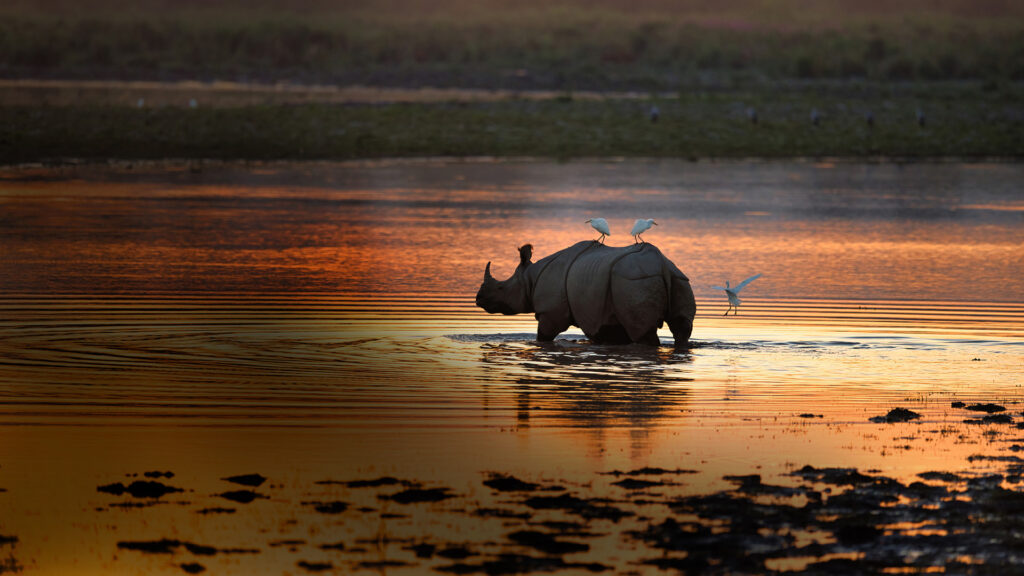
in Kaziranga National Park.
“WE HAVE BLANKETS FOR YOU,” OUR guide, Rakesh, points to our seat, one fine wintery morning. We’ve just boarded a jeep at the Diphlu River Lodge, our abode near the Kaziranga National Park. With hoods and gloves covering our heads and cold palms, we’re all set for what promises to be the ride of a lifetime. As the jeep picks up speed and slices through the dawn’s mist, the nip in the air turns into a freezing blast. Half an hour later, it’s almost a relief when the vehicle slows down to enter the gates of the Agaratoli zone in the eastern reaches of the park. “Will we see the rhino today?” I ask, leaning forward. “You’ll see so many that you’ll stop counting,” Rakesh smiles. The ‘one-horned unicorn’ of Assam is not so elusive anymore. And I can’t wait to enter the jungle.
All Creatures, Great and Small
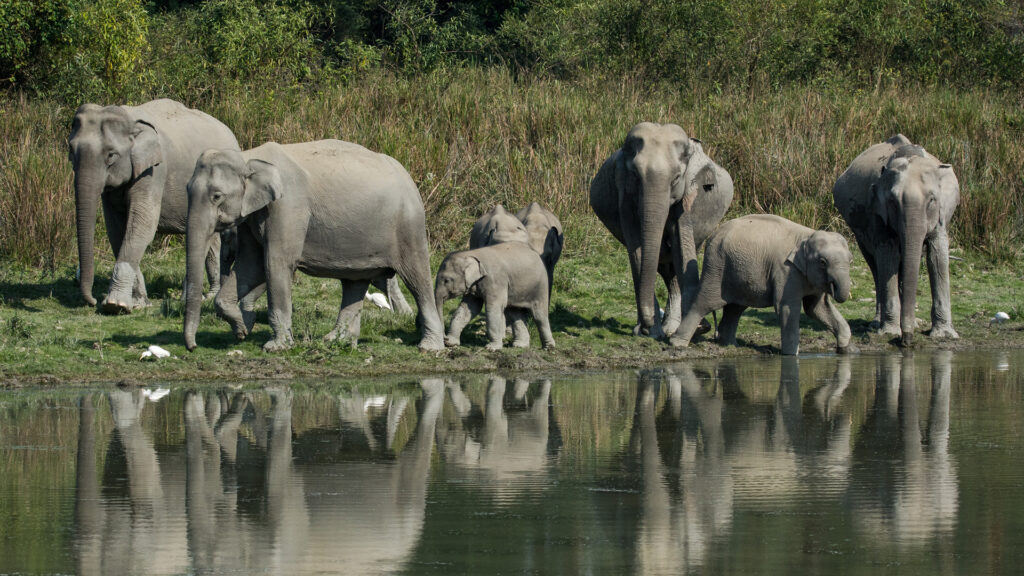
We gently rumble along a dusty path, cutting through an immense expanse of elephant grass, tall enough to hide herds of gentle giants. The sky is slowly turning a crisp blue and I can’t take my eyes off the sea of golden savannah stretching endlessly in every direction. This is abundant fodder for the park’s herbivores, particularly the greater one-horned rhinoceros, also known as the Indian rhinoceros or the Rhinoceros unicornis. Crowned as a UNESCO World Heritage Site, Kaziranga’s status as one of the most biologically diverse regions on the planet cannot be stressed enough. Apart from the rhino, it’s also home to the Asian elephant, wild water buffalo, sloth bear, five types of deer, capped langur, hoolock gibbon, gaur, and a sizeable tiger population. Essentially, the park is a virtual nirvana for
wildlife enthusiasts.
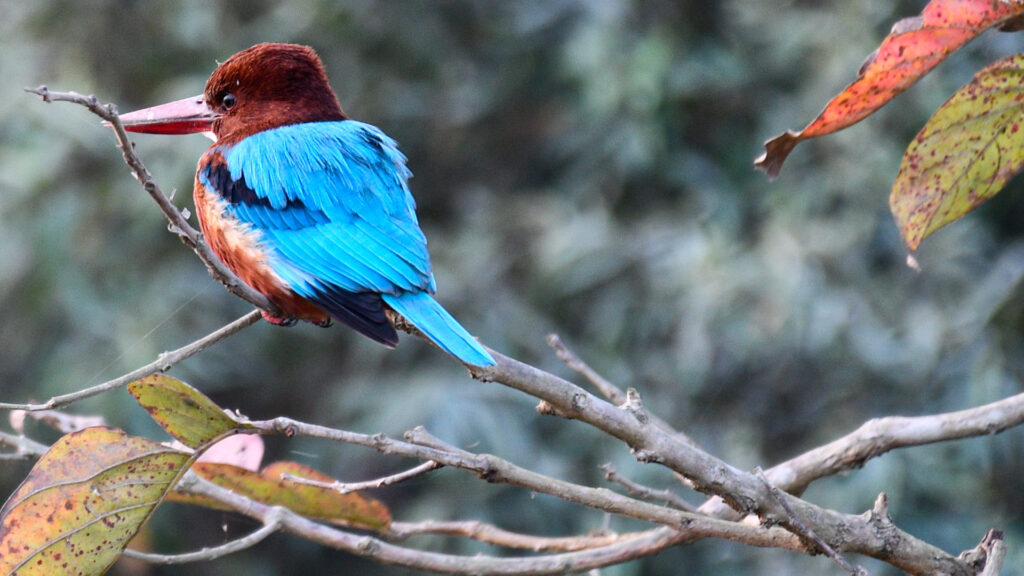
“Look, elephants!” Rakesh alerts us. Before we can even blink, a procession of five tuskers emerges through the tall grass, only to disappear from sight in a matter of seconds. There’s no scope for disappointment to settle in, however. At a clearing ahead, we see some splashing about in a pond, spraying water merrily into the air—and this time, we have our cameras ready!
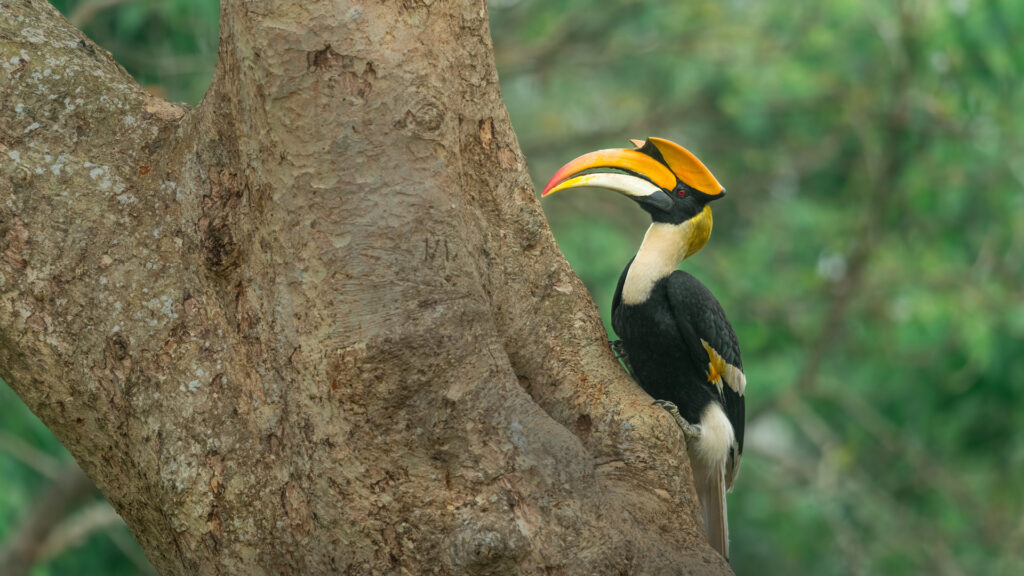
As we move along, we occasionally, stop the vehicle to study the colourful birds that catch our attention. The park’s wetlands attract many migratory species in winter and we’re lucky to be here during prime season. It’s a riot of hues as we identify a turquoise Indian roller bird, green bee-eater, blue kingfisher, grey-headed fish eagle, white spot-billed pelican, and an orange minivet. “All creatures great and small…” I hum the Anglican hymn, as we see a slimy king cobra napping in a ditch, a sambar deer at full alert, and otters swimming playfully in a stream. A trio of turtles queues up on a leaning branch, heads raised in choreographed style. Oh, the joy of being the sole vehicle in the raw wilderness sans the pressures of a convoy of jeeps!
Conversations about Conservation
Eventually, we make a pit stop near a watchtower and climb to the top for a 360-degree view. Below us, the park sprawls over 430 square kilometres of the northern floodplains of the Brahmaputra. I zoom in on a herd of wild gaur with deadly curved horns. Rakesh mentions that 70 per cent of the world’s Indian rhino population lives here. He then goes on to narrate one of the nation’s most triumphant wildlife conservation stories and we are rapt with attention. In 1908, there were only a handful of Indian rhinos in the country. Thanks to strict surveillance by 223 anti-poaching camps—with one base located every 5.82 square kilometres—there’s been a significant uptick in the species’ population. And as per the 2022 census, there are 2,613 Indian rhinos in Kaziranga. Now, that’s a success story for the ages!
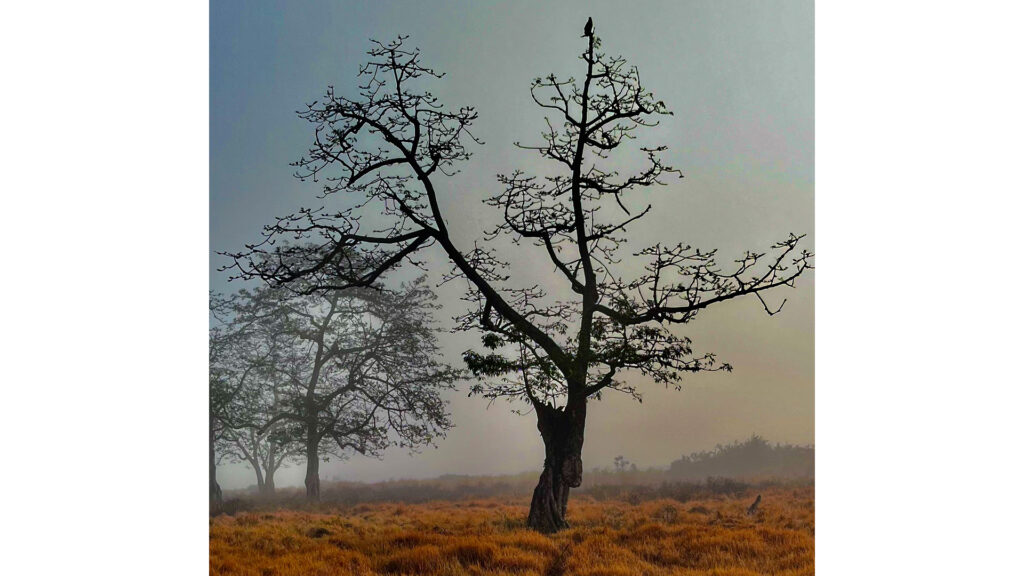
Fuelled by gratitude that we get to see these mighty creatures thrive in their natural habitat, we move on along our trail. The landscape shifts dramatically when the jeep swerves off the track to enter dense tropical forests. Towering trees form shaded canopies overhead, filtering the sunlight into dappled patterns. A barasingha deer horn lies discarded on the side of the dusty trail: a vicious fight amongst beasts or a deadly end, perhaps. Suddenly, the driver grinds to an abrupt halt—he’s just heard a series of grunts and roars echoing in the air. Through the cluster of branches, we strain to see vibrant plumage, an oversized bill, and a distinctive yellow and black curved casque. It’s the great hornbill! All eyes are focused excitedly for an eternity until the exotic bird noisily soars overhead and disappears—it’s a sight I will never forget.
The Realm of the Rhino
Later in the day, Rakesh has planned a ‘rhino-special’ afternoon for us in the Bagori zone, located in the western part of the park. He explains that spotting rhinos is easy in this area because it’s dotted with swamps, lakes, streams, and open grazing land. We haven’t spotted a rhino yet, so the anticipation is sky-high. Barely 20 minutes later, our patience is rewarded. Almost face-to-face with the rhino, we are enamoured by its majesty—despite weighing anywhere between 2,260 and 3,000 kilograms, its agility is astonishing! Rhinos can run at speeds of over 50 kilometres an hour and we witness it first-hand. This one’s a solitary male with thick, dark-grey skin that reminds me of a steel armour with plates. I study the leathery skin that falls like loose coat sleeves over its legs, the thick folds that wrinkle at its neck, and the wart-like indentations on its body. Its face is dominated by a sizeable, elongated snout, small hairy ears, tiny, intense eyes, and a sharp, wood-like horn. The horn, Rakesh explains, can grow up to 20 to 57 centimetres in length. Vulnerable yet violent, fragile yet fierce, the hulk-like rhino packs in a misproportioned grandeur that is hard to ignore. Beauty or beast—I struggle for an analogy!
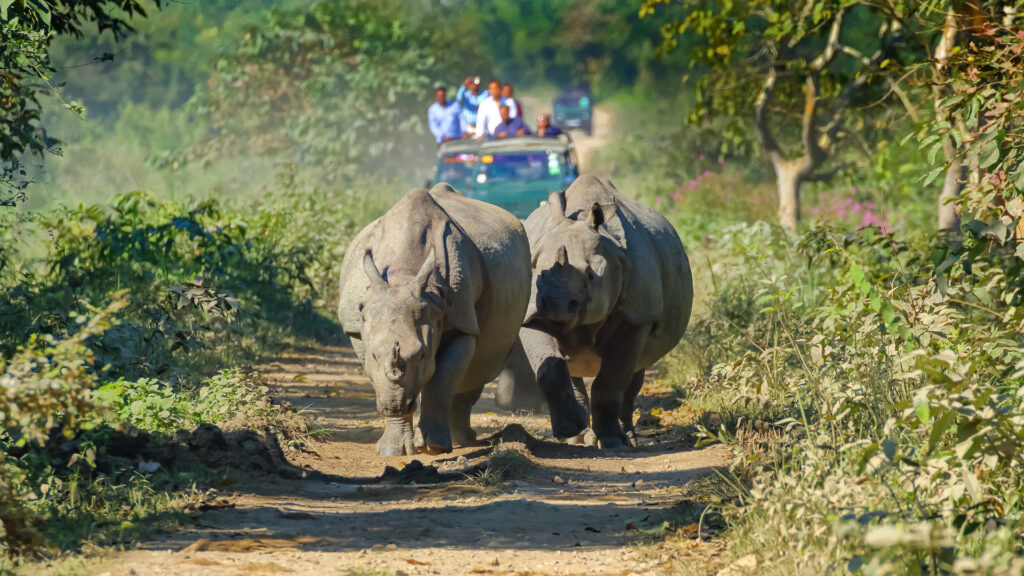
commanding majesty along a safari path.
And that is just the beginning. We also come across a pair of massive rhinos, half immersed in a swamp, a mother leading her calf into the protective cover of the thickets, and some grazing peacefully near the river, their imposing figures creating a picturesque tableau against the rugged backdrop.
As the jeep weaves its way towards the park entrance, nature bestows one last awe-inspiring moment upon us. The silhouette of a single male rhino outlined against the backdrop of a sparkling, silver river; a solitary sentinel in the fading light. We wait to capture the alchemy of the ethereal scene, gazes locked at the sight of the crimson ball of fire dipping languidly into the rippling waters. Surrounded
by the soft sounds of the river and the distant calls of the wild, we continue, only to be stopped by a rhino lumbering out of the grasses to cross the jeep’s path. “First right of way,” I voice silently. After all, in the jungle, we humans are the outsiders.
Circle of Life
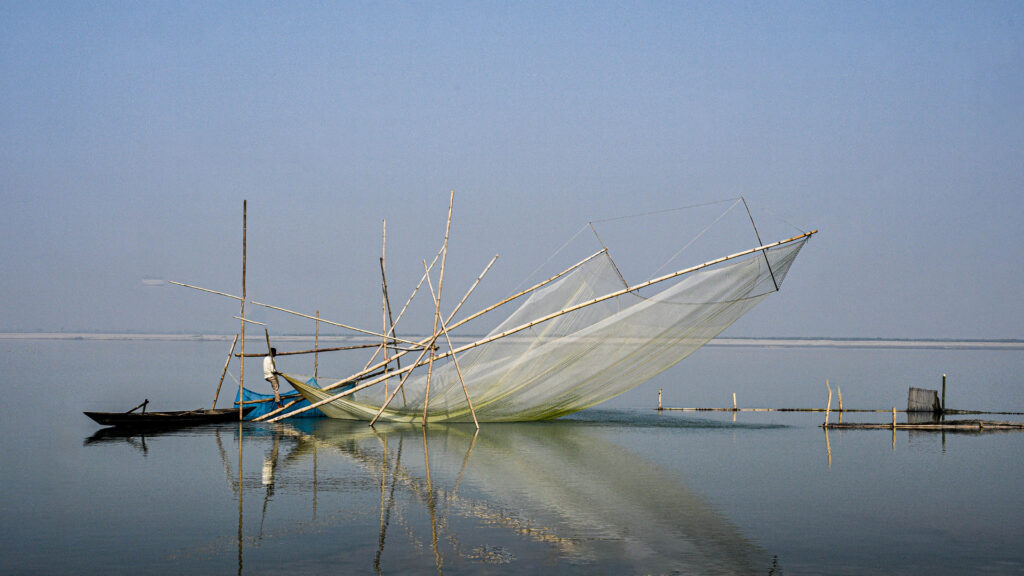
The following day, on a cruise in a country boat, we glide along the Brahmaputra—a river that’s often alluded to as a moving ocean. Sleek bodies of dolphins break the surface in an aquatic ballet, navigating the twists and turns with intuitive finesse. Stretches of sandbanks stand bathed in the soft luminescence of the morning light, like a strip of ivory silk between the soft palette of powder blue and pale green. A fisherman casts an intricate web of bamboo and twine into the waters with unhurried precision, creating a wave in the mirrored surface. I soak up the serenity of this timeless daily ritual.
It’s fascinating to think about the river’s tumultuous relationship with Kaziranga. Every monsoon, the Brahmaputra swells and swallows up more than two-thirds of the park, with the flood both disrupting and rejuvenating the ecosystem. At this time of the year, all animals, including deer, elephants, tigers, and rhinos, seek refuge in the adjacent hilly Karbi Anglong district, often crossing the busy NH37 highway packed with speeding trucks: a unique phenomenon native to this extraordinary land of untamed beauty.
All are ensconced in the flawless rhythm of the circle of life and unfailing rules of the ecosystem… and we are blessed to witness it all, one speck at a time.
Related: The Ultimate Guide To Exploring Galicia, A Hidden Gem In Spain




